Saddam Hussein was the dictator of Iraq from 1979 until 2003, when he was overthrown by a U.S.-led invasion. Hussein was born in Tikrit, Iraq, in 1937. He joined the Baath Party in the 1950s and took part in a 1963 coup that brought the party to power. Hussein became head of state in 1979 and launched a bloody campaign against his political opponents. He also invaded Iran in 1980 and Kuwait in 1990. In 2003, a U.S.-led coalition invaded Iraq and toppled Hussein’s regime. Hussein was captured by U.S. troops in December 2003 and was tried by an Iraqi court. He was found guilty of crimes against humanity and executed by hanging in 2006.
Saddam Hussein was the dictator of Iraq from 1979 until he was overthrown by the U.S. military in 2003. He was known for his brutality, using chemical weapons against his own people and leading Iraq into two devastating wars against Iran and Kuwait.
Who was Saddam Hussein and what was he known for?
Saddam Hussein was the dictator of Iraq from 1979 until his overthrow in 2003. He was born to a peasant family near Tikrit and became involved in the anti-British, Arab nationalist ideology of the day. Saddam was a brutal ruler, and his regime was responsible for numerous human rights abuses. He was finally captured by a US-led coalition and was executed in 2006.
Saddam Hussein and the Baath party used violence, killing, torture, execution, arbitrary arrest, unlawful detention, enforced disappearance, and various forms of repression to control the population. These methods were used to target political opponents, ethnic and religious minorities, and other groups deemed to be a threat to the Baath party’s power.
Why did Saddam invade Iraq
The link between Saddam Hussein’s government and terrorist organizations, in particular al-Qaeda, was one of the justification for invasion of Iraq. There was no concrete evidence to support this claim and it was later found to be false.
Saddam Hussein was executed on December 30, 2006, for ordering the massacre of more than 140 Iraqis in the village of Dujail. He was buried on December 31 in Tikrit.
Was the US allied with Saddam Hussein?
It is now known that more than 60 US Defense Intelligence Agency officers provided combat planning assistance to Saddam Hussein’s military. This was done in addition to the US providing battlefield intelligence including satellite pictures.
Saddam Hussein’s legacy is still a controversial and polarizing issue more than a decade after his death. Saddam was overthrown in April 2003 following the US-led invasion of Iraq, and executed for crimes against humanity in 2006. But many Iraqis still view him as a hero who fought against Western imperialism, while others see him as a brutal dictator who terrorized his own people. There is no easy answer when it comes to assessing Saddam’s legacy, but his impact on Iraq and the world is undeniable.
What did Saddam say before he died?
This is a very powerful quote from Saddam Hussein just before his execution. It shows his dedication to jihad and fighting aggression, and also his confidence in the ultimate victory of the Muslim Ummah. This is a reminder to all of us that we should never give up on our principles, even in the face of death.
The stated aim of the coalition was to disarm Iraq of weapons of mass destruction and to end Saddam Hussein’s support for terrorism. However, a UN inspection team found no evidence of these things. It is possible that the coalition overestimated Iraq’s WMD capabilities, or that they were not completely honest about their reasons for going to war.
Did the U.S. get oil from Iraq
The United States imported an average of 157,000 barrels of petroleum per day from Iraq in 2021. This was a significant decrease from the average of 548,000 barrels per day in 2020. The decrease was due to the expiration of the Iraq-US trade agreement in January 2021.
In 2008, President Bush agreed to a withdrawal of all US combat troops from Iraq. The withdrawal was completed under Barack Obama in December 2011.
What was Saddam Hussein’s religion?
Saddam adhered to an eccentric interpretation of Islam that Ba’thist intellectuals had developed in the mid-twentieth century. For him and many other Ba’thists, Islam was the religion of the Arabs, Muhammad was an Arab prophet who preached a divine message intended for his Arab followers. Islam, Saddam believed, should be used to further Arab unity and should therefore be free from foreign, particularly Western, influence. This meant, in Saddam’s view, that Muslims should not follow the interpretations of the Quran and Hadith developed by non-Arabs, and that they should not defer to the authority of non-Arab Muslim scholars.
Saddam Hussein, the former president of Iraq, was captured by the United States military in Ad-Dawr, Iraq on December 13, 2003. The operation was codenamed “Operation Red Dawn” after the 1984 American film Red Dawn.
When did US invade Iraq
There are a few things to keep in mind when writing a note. First, make sure to keep it short and to the point. Second, be sure to address the intended recipient by name. Finally, be sure to sign your name at the end.
The United States formally ended its combat mission in Iraq on 9 December 2021, with 2,500 troops remaining in the country. As of 30 December 2022, the number of American forces in Iraq is estimated at about 2,000 soldiers deployed mainly in Al Asad Airbase, Camp Victory and Al-Harir Air Base.
How safe is it to travel to Iraq?
If you are in Iraq, we advise you to stay alert and monitor local news sources for updates on new threats in your area. The security situation in Iraq is volatile and there is a very high risk of violence, armed conflict, kidnapping and terrorist attack. We continue to advise against travelling to Iraq, including the Kurdistan Region of Iraq.
Despite the vote to withdraw from Iraq, President Donald Trump initially refused to do so. However, he began withdrawing forces in March 2020. Trump’s decision to withdraw troops from Iraq was controversial, and many felt that it was a mistake.
Final Words
Saddam Hussein was the dictator of Iraq from 1979 until he was overthrown by the US-led invasion in 2003. He was born in Tikrit, Iraq in 1937, and rose to power as a member of the Ba’ath Party. He was known for his brutal regime, and for his use of chemical weapons against his own people.
Saddam Hussein was the President of Iraq for over two decades, until he was deposed in 2003. A Sunni Muslim, he was one of the most controversial leaders in the Arab world. His rule was often characterized as autocratic and repressive, and he was accused of human rights abuses and other crimes. In the 1980s, he engaged in a long and bloody war with Iran, and in the 1990s, he invaded Kuwait, leading to his eventual downfall.





